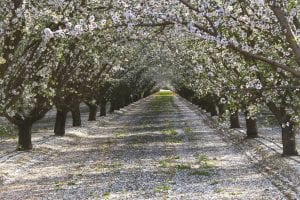In today’s Almond Matters, brought to you by Valent, weather this winter has been significantly different from last year and may intensify the need for extending bloom in almond orchards. The weather leading up to bloom and the weather during bloom can have a big impact on the need to extend the bloom period.
 “The potential for extending bloom will become important under a couple of different weather scenarios that can happen during bloom. If it gets really warm bloom can speed up really fast and obviously in those situations, you’d love to have a couple of extra days for pollinization,” said Manager of Field Development for Valent U.S.A. Pat Clay. “The other scenario is where it turns cold or cooler, bees aren’t flying and aren’t as active. So that could be another situation where that extension of the bloom period could be very valuable to the grower.”
“The potential for extending bloom will become important under a couple of different weather scenarios that can happen during bloom. If it gets really warm bloom can speed up really fast and obviously in those situations, you’d love to have a couple of extra days for pollinization,” said Manager of Field Development for Valent U.S.A. Pat Clay. “The other scenario is where it turns cold or cooler, bees aren’t flying and aren’t as active. So that could be another situation where that extension of the bloom period could be very valuable to the grower.”
California has received a much greater amount of rain compared to last winter and temperatures have also created some conditions for a potentially strong bloom this year. “Bloom is different every year but what I’m hearing from the field and a lot of PCA’s that I talk to is this might be the first ‘normal’ year we’ve had in the last ten years, ” said Clay, “what we’ve seen is good rainfall, fairly moderate temperatures, we’ve had some good fog that helps with the chill. So, overall it’s setting up to be a pretty good bloom.”
Ethylene production in almond flowers begins once bloom occurs and causes the flower to senesce. Once a flower begins to decay it severely limits the possibility that flower will be pollinated. Extending the bloom period can improve nut-set potential by providing a longer window of time for bees to pollinate more flowers. Clay noted that using a plant growth regulator such as ReTain during bloom “inhibits that ethylene production and keeps that flower viable for a couple of extra days.”
Listen to the interview below.










